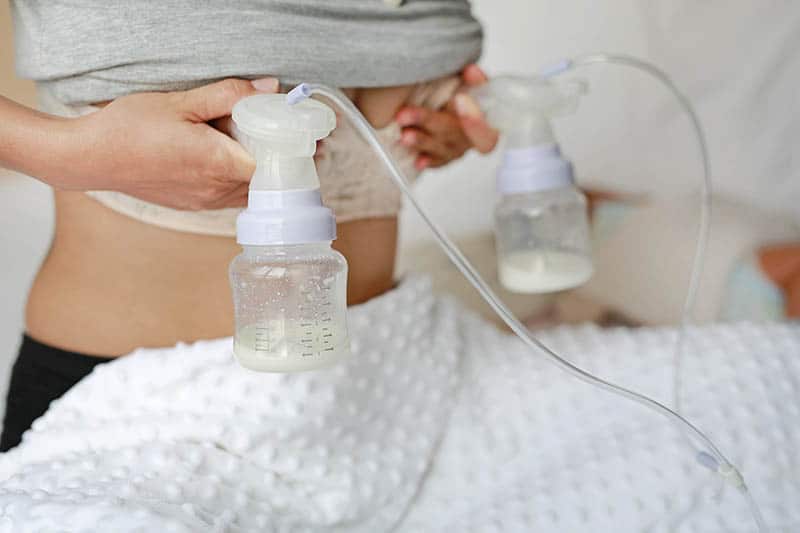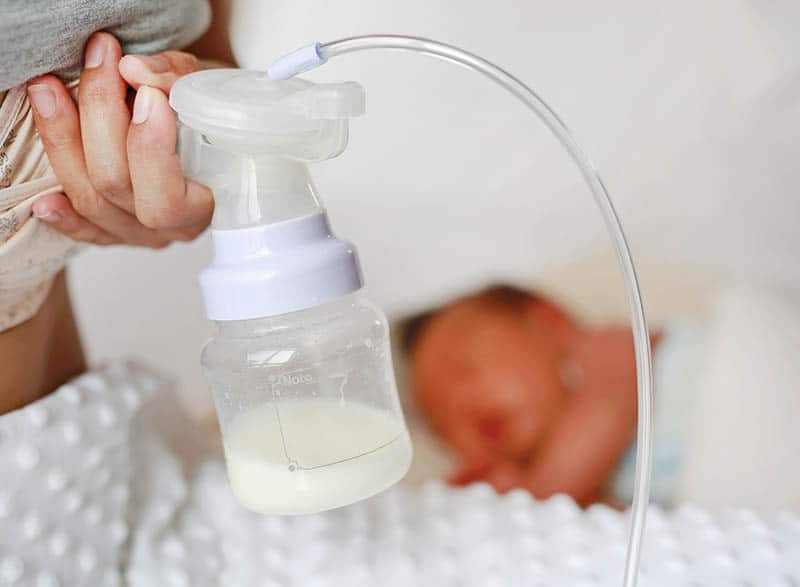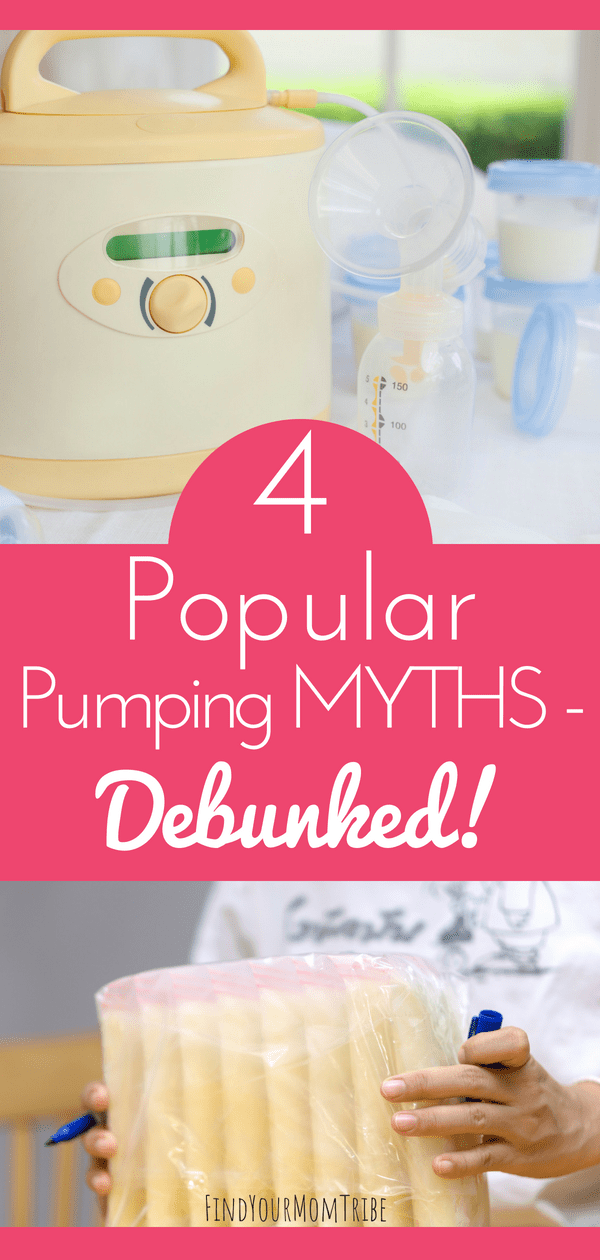I’ve been seeing a ton of pumping tips floating around on Pinterest lately – which is great!
I love helping moms learn to pump more milk for their babies, and I love that Pinterest is a great place for moms to go to get information and advice.
BUT …there are a few popular pumping myths out there that need to be debunked and that moms need to know about before they start pumping.
And if you’re already pumping breast milk for your baby, let me know if you buy into these myths!
Pumping Myth #1: Refrigerate your pump parts between uses.
I’m not sure where this idea originated, but one popular pumping myth is that you don’t need to wash your pump parts in between pumping sessions.
You can just rinse and toss them in a ziplock bag and place them in the fridge until the next time you pump.
It sounds like a good idea at first…I mean, fewer pump parts to wash?!
But when you do a little digging, you won’t find any leading health organizations or peer-reviewed studies advocating for this time-saving pumping hack.
I mean, it might be okay to do once in a while if you’re in a pinch… BUT I would never do this if my baby was premature, sick, or if we were battling thrush.
Overall, the verdict is: wash your pump parts between uses.
I know it’s a lot of work, so if you exclusively pump, I definitely recommend getting some spare pump parts and bottles so that you aren’t spending hours of your day at the sink.

Pumping Myth #2: Dream feed your baby morning milk
I saw an article recently where a mom said that her pediatrician told her to write down the time of day she pumped milk, and then dream feed her baby breast milk at night that had been pumped in the morning because it was higher in protein and would help the baby sleep longer.
First let me say, no disrespect to the mom who suggested this…but this is only partially true.
Let’s look at what science has to say.
It’s true that breast milk changes throughout the day. And here’s what’s really cool…
Breast milk actually contains sleep-inducing amino acids and nucleotides. (Yay, sleep!)
Concentrations of this sleepytime magic are highest between 8 pm and 8 am. (You can read the research here.)
So yes, definitely write on the storage bag the time you pumped the milk… But milk pumped at night should be fed to the baby at night to help him sleep better.
RELATED: Dream Feed: What It Means For Your Baby And How To Do It
Researcher Cristina Sanchez said, “You wouldn’t give anyone a coffee at night, and the same is true of [breast] milk – it has day-specific ingredients that stimulate activity in the infant, and other night-time components that help the baby to rest. It is a mistake for the mother to express the milk at a certain time and then store it and feed it to the baby at a different time.”

Pumping Myth #3: Pumping is painful
Pumping breast milk for your baby shouldn’t be painful.
If you’re experiencing pain while pumping, it could be several things.
- Be sure you have the right size flanges. You may need to size up or down!
- You can also check out Pumpin’ Pals flanges that are more comfortable to use.
- Be sure to use a non-toxic nipple balm after you pump to prevent sore nipples.
- Don’t crank up the suction power to the max. It’s okay to start off with softer suction and then gradually increase.
- If all else fails, you may need a different pump. Here are my recommendations:
| Image | Title | Price | Buy |
|---|---|---|---|
Top Top
Top | Medela Pump in Style Advanced with On the Go Tote, Double Electric Breast Pump | Buy Now | |
 Top
Top | Spectra Baby USA - S2 Plus Premier Electric Breast Pump, Double/Single, Hospital Strength | Buy Now |
Pumping Myth #4: Exclusively pumping breast milk isn’t a long-term option
Many lactation consultants (and well-meaning friends/family) will tell you that you can’t pump breast milk long-term.
This is absolutely false.
Milk production is (mostly) about emptying your breasts frequently. If you do this, your body will make milk.
RELATED: 12 Questions You Must Ask Yourself if You Struggle with Low Milk Supply
When my first daughter was born, we struggled with nursing. (You can read about how the hospital sabotaged my breastfeeding experience here.)
So, I decided to exclusively pump.
Several lactation consultants and pediatricians told me that I wouldn’t be able to express enough milk exclusively pumping and that my supply would eventually dry up.

But I was able to successfully pump plenty of milk for her — for 13 months! Woohoo!! (And I know many, many mamas who have done the same for their babies.)
Bottom line? If you choose not to nurse (or can’t!), exclusively pumping is possible.
Yes, it takes lots of dedication, but it is totally worth it.
READ NEXT:
- 10 Little-Known Tricks to Pump More Breast Milk
- Power Pumping: Facts You Should Know Before Trying It
- How To Pump More Breast Milk: 20 Tips To Increase Milk Supply
Like this post? Please share or pin it for later. You can also stay in the loop and follow us on Facebook, Instagram and Pinterest.

We love honesty! Find Your Mom Tribe is an Amazon Associate and we earn from qualifying purchases through affiliate links at no extra cost to you. Please see our full Amazon Affiliate disclosure for more information.


Firefly Magic
Wednesday 15th of August 2018
This is a really interesting article! Your tips for making sure pumping doesn’t hurt are SO worth it! Weirdly, my pediatrician actually told me to keep my pump parts in the fridge but I never did! It grosses me out! Luckily I DO have a spare set so I can cut down on the number of times I do baby dishes anyway. It IS so helpful!
Marianna
Saturday 18th of August 2018
Hmm, that's really interesting that your pediatrician recommended keeping pump parts in the fridge! I wonder where they got that idea from! Thanks for stopping by! Marianna